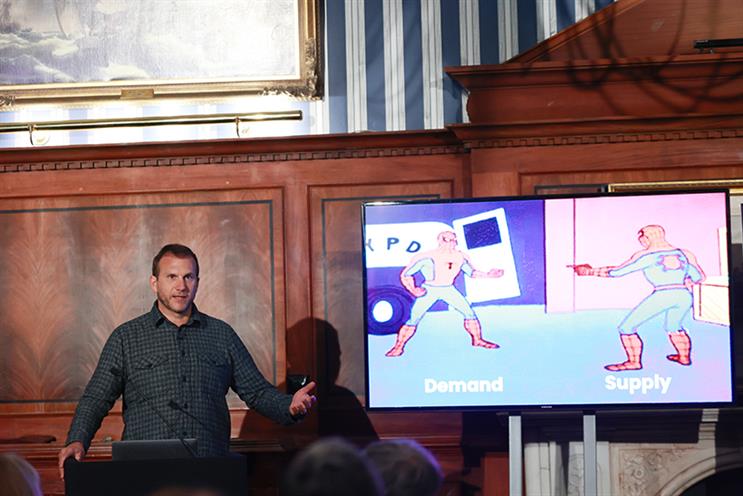
Out-of-home advertising has come a long way since the days of scrolling posters, says Lee Cutter, Hivestack’s VP of sales for the UK and emerging markets. At Campaign’s Media360 conference, he outlined the key reasons for brands to enter the programmatic digital space.
1. The infrastructure is in place
In case you hadn’t noticed, we now live in a world of digital advertising screens, noted that the number in the UK has multiplied from around 6,000 to 35,000 or so screens in just five or six years. There is a wide range of environments available to advertisers, from gyms and offices to taxis and even chicken shops.
“There are so many different venues in which you can step into the digital space, which contextually relevant,” said Cutter. “Globally, monthly impressions approach a trillion.”
2. Audience targeting is smarter…
Programmatic DOOH is about aiming smarter, not smaller. “It’s not about looking for a left-handed guy in Wales who’s also a vegan; it’s about looking at audiences at scale, and trying to eliminate wastage,” he said.
That means analysing audiences’ movements, understanding the best moment to target them, and then activating the best possible screen in terms of creative, format and siting.
3. …And so is measurement
Measurement capabilities are also becoming increasingly sophisticated, with the ability to track footfall, sales uplift, brand awareness and brand sentiment to understand the impact of DOOH campaigns.
High-end fitness brand Hydrow successfully used Hivestack’s programmatic DOOH platform and geolocation technology to target affluent users of gyms, rowing clubs and shopping malls in UK cities. Hivestack’s follow-up research showed there was a 29% increase in brand awareness among those exposed to the ad, and a 26% increase in purchase intent.
4. It’s easy to change tack
Flexibility and in-flight optimisation are two of the big pluses of a programmatic DOOH .
Advertisers can start, pause or stop campaigns, change creative strategy or move around budgets at the click of a mouse.
5. Moments DOOH matter
As Cutter sees it, the potential to use real-time data to shape programmatic DOOH campaigns is much greater than, “Hey, it’s sunny, let’s trigger an ad for an ice cream”.
While weather remains important in the dynamic creative optimisation (DCO) of out-of-home ads, other data such as traffic conditions, lifestyle factors and live news and sports events can also help create “contextual moments” to connect with audiences. By way of example, Cutter mentioned screening an England goal in the Euros: “Can you imagine owning that moment, as a brand?”
DCO can also help target niche, as well as mass, audiences. Hivestack have even created a birdspotting “moment”, drawing on carpark data near popular birdspotting sites and keyword searches for bird life.
6. We’re all thinking omnichannel
DOOH didn’t used to be part of the omnichannel party, but that’s no longer the case, says Cutter. With the rise of connected TV and digital audio, we’ve seen programmatic ad spend increasing – and he expects this to rise as brands strive to deliver joined-up experiences across all channels.
7. It offers global reach
Often, advertising is planned within country silos – but programmatic DOOH platforms allow brands to reach global audiences, said Cutter. “Do a bit of paperwork, and you can have seats in every market you want.”
He gave the example of Hivestack’s work with Gucci on the brand’s Beloved campaign, which launched in London, New York, Tokyo, Singapore and Milan. Over 100 creative formats were used, drawing on Gucci’s first-party data to influence which creative was triggered in particular locations. The campaign netted 100 million impressions across three continents.
8. It’s a streamlined approach
As Cutter noted, there are essentially three ways to transact out-of-home advertising: direct booking with a rep by phone; an online booking platform that provides a level of automation but doesn’t use real-time data; or programmatic, which can use advanced protocols such as OpenRTB 2.6 to automate transactions in real time.
While programmatic DOOH may sound complicated, for Cutter it’s all about “streamlining and evolving” the ad-buying process. But he believes education and talent are necessary to realise its full potential – and the most successful teams implementing it combine out-of-home experience with programmatic .
9. DOOH complement your social media
Need any convincing that out-of-home and social media campaigns are a match made on-screen? Look to the tech giants, said Cutter, who often use both to get the message across.
Or Nike, whose massive digital billboard of a victorious Emma Raducanu after the US Open was promptly shared on Instagram by the thrilled tennis player. Her clip of herself posing in front of the ad in New York was picked up by press outlets and relayed worldwide.
As Cutter pointed out, the innate shareability of out-of-home content was key to this success. “I’ve never seen anybody do that with an online ad.”
10. Video is the future
The visual possibilities of programmatic DOOH are now truly attention-grabbing. Many of today’s out-of-house screens support dynamic content that responds to passers-by, while some allow for cinema or TV video ads to be screened.
Another exciting development is 3D effects – as in Hivestack’s recent collaboration with global real estate brand Re/Max on the world’s first programmatic DOOH anamorphic video campaign which ran in Cape Town, South Africa. Larger-than-life 3D visuals of dream home items, such as a floating dog, appeared to emerge from billboard screens stopping audiences in their tracks.
So perhaps the strongest argument for opting for programmatic DOOH is also the simplest: as Cutter put it, you can do “amazingly creative work”.
Watch the presentation in full:
Find out more about how programmatic DOOH could help you connect with audiences at hivestack.com


